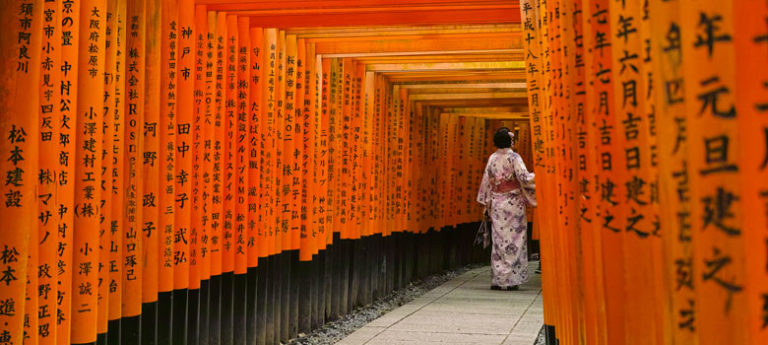Kyoto, Japan: Fushimi Inari Shrine
© KarmaWeather by Konbi - All rights reserved
Cover picture by Bethom33 (source, license) Changes: framing
History, facts, legends and travel guide about Fushimi Inari Taisha, one of Japan's most mystical destinations
Fushimi Inari Shrine
History, geography
Fushimi Inari Taisha (伏見稲荷大社) is one of the most important Shinto place of worship in Japan, whose origins (711 AD) precede the installation of the capital of the empire of Japan in Kyoto (794 AD). Located south of Kyoto Prefecture, Fushimi Inari is a place of pilgrimage as popular with the faithful as with hikers. Indeed, the tunnels formed by the rows of more than a thousand vermilion Torii gates inside the sacred forest of Inari hill up to its summit at 233 meters above sea level, then circling back to the main entrance of the shrine, constitute an excellent hiking destination, as sporty as it is steeped in mystery.
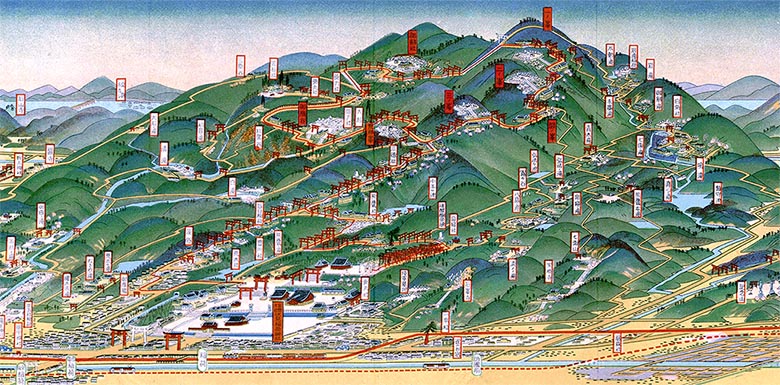
Illustrated map of Mount Inari and the Fushimi Inari Taisha Shrine
(detail, 1925) By Hatsusaburō Yoshida (吉田 初三郎, 1884-1955) (source)
Planning a visit to Fushimi Inari Shrine
To get to Fushimi Inari temple, the easiest way is to take the train from Kyoto Station, on the JR Nara line and stop at Inari station. The journey takes 5 minutes and costs 300 yen back and forth.
- Address: 68 Fukakusa Yabunouchicho, Fushimi Ward, Kyoto, 612-0882, Japan
- Phone: +81 75-641-7331
- Entrance fee: Free
- Opening hours: 24 hours a day all week
- Fushimi Inari at night: The Fushimi inari hiking route is lit all night
- Catering: On-site, traditional stalls and restaurants offer fried tofu, Kitsune Udon (fox noodles) or Sushi Inari
Fushimi Inari Facts
Honden, the main hall of Shinto shrines
Torii gates, gateway to the spirit world
At the main entrance to the Fushimi Inari shrine, at the foot of Mount Inari, is the main gate or "Tower Gate" (楼門), built in 1589 by the mighty Toyotomi Hideyoshi (豊臣 秀吉, 1537-1598), who, although he never reached the title of Shōgun, was in his time the greatest feudal lord and politician of the Sengoku period, which ended during his time in power. The son of a simple soldier, he was a brilliant strategist and negotiator who rose through the ranks of power and aristocracy in medieval Japan. Great benefactor of the Fushimi Inari Shrine, commonly called the "great unifier" of Japan, he was nicknamed, both because of his physique and his keen intelligence, the "little monkey" or the "bald rat". No link however between his nicknames and his Chinese zodiac sign, since born on March 17, 1537, he was of the Year of the Fire Rooster.
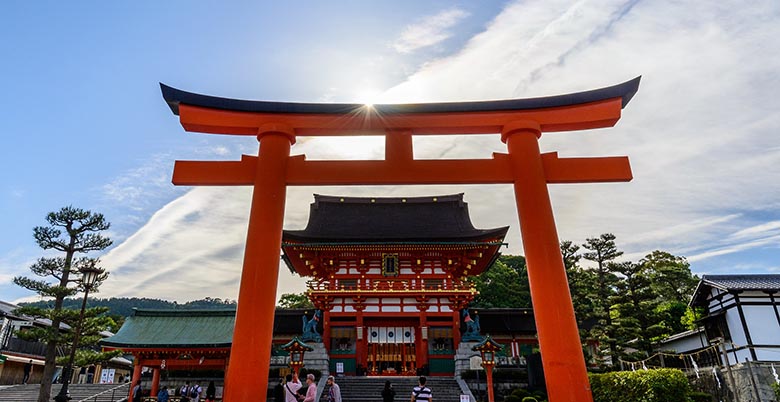
© dconvertini (source) License Changes: framing
Behind the tower gate stands the predominant building of the sanctuary, the main hall or Honden (本 殿), which plays a fundamental role in Shinto holy places and in front of which visitors can, after the customary ablutions, pray and make a small donation in order to attract the good graces of Inari, protective spirit of agriculture and rich and successful businesses.
Shinto shrines are home to deities whose sculptures and sacred objects are hidden from view in the heart of the Honden. It is customary to come to pray and make offerings in Shinto shrines to attract luck, good health and prosperity, and this especially during the great events of life: birth, marriage, Japanese Lunar New Year, Setsubun (節分) and other festivals.
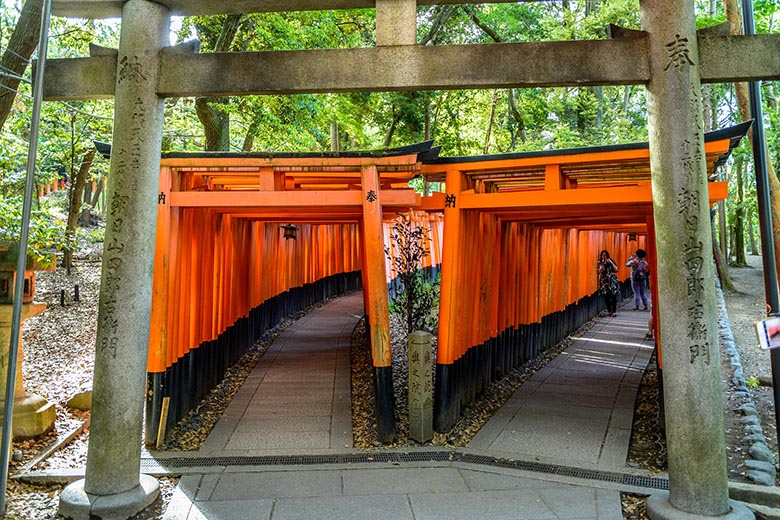
© dconvertini (source) License Changes: color calibration
The Torii gates (鳥居, "bird's home") are traditionally placed at the approach and at the entrance to Shinto places of worship. They symbolize the passage from the secular world to the sacred world. Their origin is not clearly defined, although variants in India, China and Korea are likely initial inspirations.
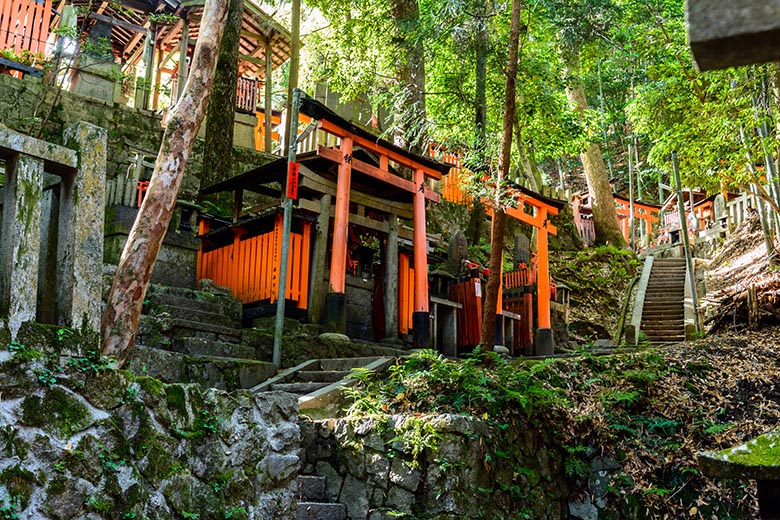
© dconvertini (source) License Changes: color calibration
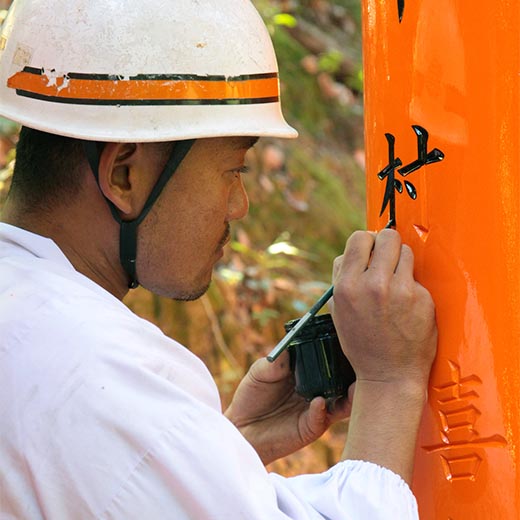
© DavideGorla (source) License Changes: framing, color calibration
Built in wood or stone for centuries, sometimes in concrete and metal today, Torii doors have developed in Japan a specific architecture with stylistic variants representative of the eras during which they were erected or their religious symbolism. Most often, Torii doors are painted in vermilion red and their base in black.
If the faithful visiting must make a modest offering during his visit to the sanctuary, the Torii gates are the result of significant donations from individuals and companies (up to 1 million yen, a little more than $ 9,000). The name and the date on which they made their donation are then inscribed on the Torii gate erected in gratitude for the accomplishment of their wish.
Fushimi Inari Shrine in popular culture and legends
Inari, deity of agriculture and commerce
Kyoto's Fushimi Inari shrine is dedicated to Inari Ōkami (稲荷大神), the Shinto deity of rice and tea, agriculture and blacksmiths, fertility and prosperity, but also successful trade and business . Since its cult exists in Japan (around the 5th century AD), both in the Shinto tradition and in Japanese Buddhist who also adopted it, no definite gender identity has ever been attributed to Inari. Inari is therefore sometimes represented as a man, sometimes as a woman or even androgynous. The feminine version of Inari is often associated with or even confused with Dakini-ten (荼枳尼天), a Japanese Buddhist deity from Hinduism and Tibetan Buddhism, represented in the form of a bodhisattva woman (sometimes wearing little clothing), riding a flying silver fox. Very popular in medieval Japan, with the aristocracy as well as people of small virtue (gamers, prostitutes), this goddess of Hindu origin was credited with powers of black magic, such as the ability to guarantee the wildest vows to those who made a pact with her, in exchange for their soul.
The fox, special messenger of Inari Ōkami
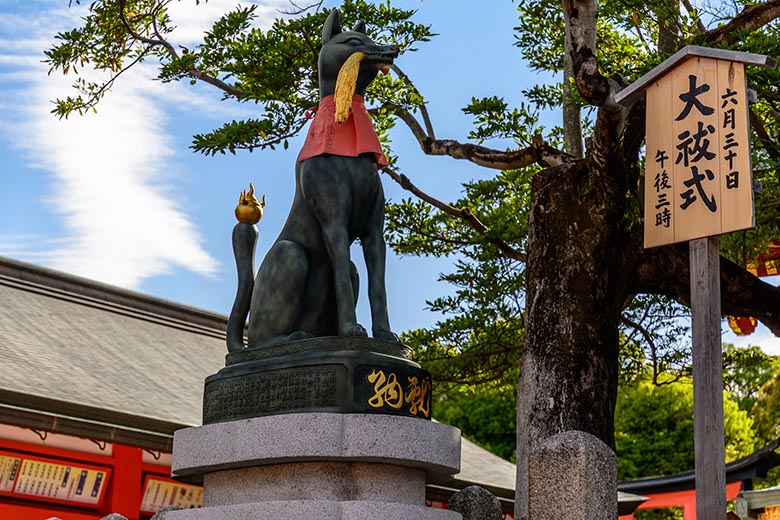
© dconvertini (source) License
While Inari Ōkami does not ride a flying fox, legend has it that he is surrounded by several foxes, who are his personal messengers. This is why the fox, associated as well with Inari the spirit god of rice as Dakini the witch goddess from India, is a symbolic animal particularly important in Japan, which managed very early to gain a unique place in the spiritual world and folklore common to all strata of Japanese society.
Let us note in passing that the words of "god" or "divinity" which we use here for ease of language are somewhat misleading in view of the Shinto tradition, especially if we maintain ourselves in a Western mode of thought where the prevailing monotheism has long watered down or absorbed the animism of the ancients. Indeed, the term used in Japan to designate the great spiritual figures is Kami (神), which by extension refers to a god or a deity, but which above all means the Spirit, the Essence of everything present in everything, and that we find as well in ancestors, natural phenomena (lightning, rain, winds) or in mountains, rocks, forests, trees and rivers.
Komainu, the two guardians of Shinto shrines
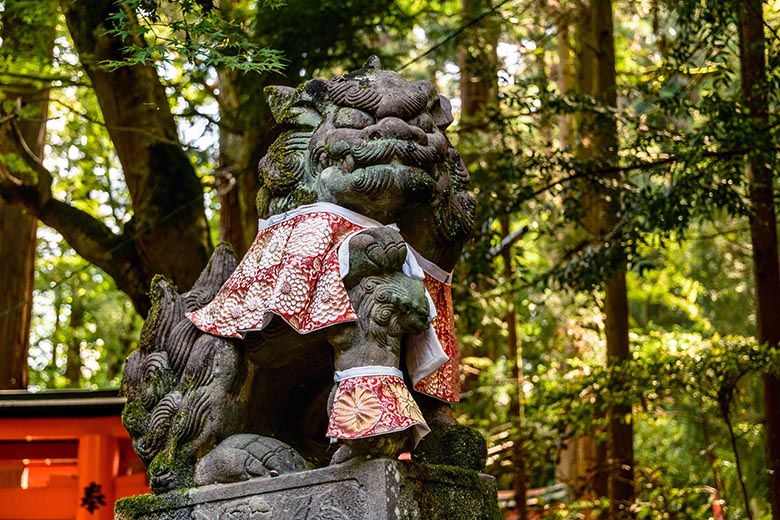
© dconvertini (source) License Changes: color calibration
Installed like guards on each side of the entrance to Shinto temples, the Komainu (狛犬) are sculptures of half-dog half-lion chimeras. However in Fushimi Inari, even if Komainu are also present to protect the holy place, the statues of foxes prevail over the traditional Komainu, because of the peculiarities of Inari, the main deity that the sanctuary has honored for almost two millennia.
Planning a travel to the Kyoto prefecture
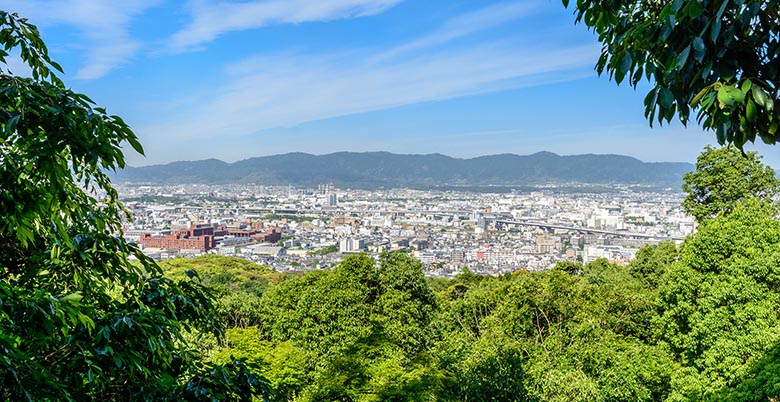
© dconvertini (source) License Changes: framing
Kyoto
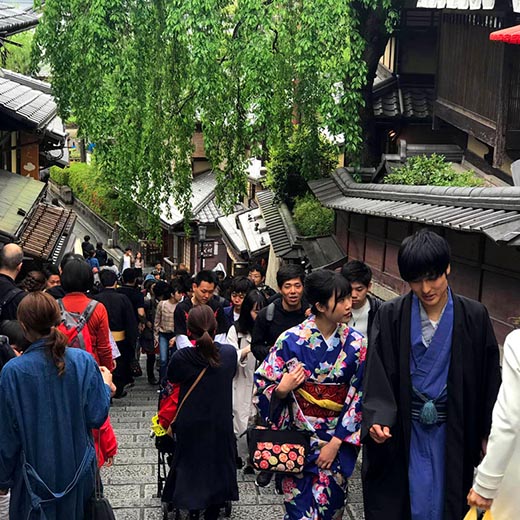
© Man Kin Fung (License)
Kyōto (京都), today the capital of the prefecture of Kyoto in Japan, was the capital of the country for almost 11 centuries, until 1869, when the imperial court moved to Tokyo. Built in a valley surrounded by three mountains and crossed by three rivers, Kyoto was originally built according to the rules of traditional Chinese Feng Shui, the imperial palace in the center facing south, while the rest of the city all around was divided into sectors according to a precise grid. The cultural footprint of this city of 1.5 million inhabitants is still very strong today, to the point of being considered one of the artistic and architectural beacons of Japan, in addition to being a renowned university center. Its many Shinto shrines, Buddhist temples, gardens and imperial villas, not to mention the imperial palace in Kyoto, were mostly spared from the aerial bombardments of the Second World War, which allows you to appreciate in all its splendor the historic Japan of the old capital of the empire. Apart from Tokyo, the lively and sparkling capital, Kyoto remains an essential tourist destination for foreign visitors who, discovering Japan for the first time, want to soak up the scent and charms of eternal Japan.
Japan's Chinese zodiac animal sign and compatibility
Find out how compatible you are with the country you plan to visit
|
